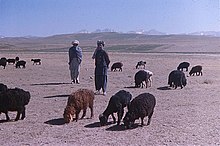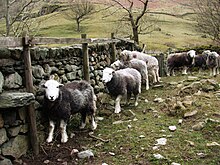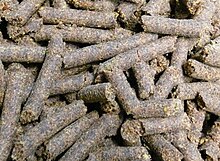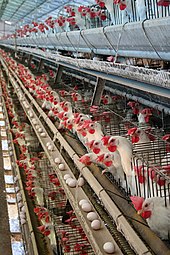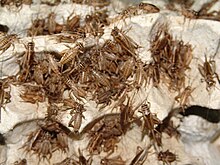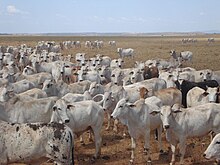Cattle feedlot in Colorado, US
Raising chickens intensively for meat in a broiler house, US
Animal husbandry is the branch of agriculture concerned with animals that are raised for meat, fibre, milk, eggs, or other products. It includes day-to-day care, selective breeding and the raising of livestock.
Husbandry has a long history, starting with the Neolithic revolution when animals were first domesticated, from around 13,000 BC onwards, antedating farming of the first crops. By the time of early civilisations such as ancient Egypt, cattle, sheep, goats and pigs were being raised on farms.
Major changes took place in the Columbian Exchange when Old World livestock were brought to the New World, and then in the British Agricultural Revolution of the 18th century, when livestock breeds like the Dishley Longhorn cattle and Lincoln Longwool sheep were rapidly improved by agriculturalists such as Robert Bakewell to yield more meat, milk, and wool.
A wide range of other species such as horse, water buffalo, llama, rabbit and guinea pig are used as livestock in some parts of the world. Insect farming, as well as aquaculture of fish, molluscs, and crustaceans, is widespread.
Modern animal husbandry relies on production systems adapted to the type of land available. Subsistence farming is being superseded by intensive animal farming in the more developed parts of the world, where for example beef cattle are kept in high density feedlots, and thousands of chickens may be raised in broiler houses or batteries.
On poorer soil such as in uplands, animals are often kept more
extensively, and may be allowed to roam widely, foraging for themselves.
Most livestock are herbivores, except for pigs and chickens which are omnivores. Ruminants
like cattle and sheep are adapted to feed on grass; they can forage
outdoors, or may be fed entirely or in part on rations richer in energy
and protein, such as pelleted cereals. Pigs and poultry cannot digest
the cellulose in forage, and require cereals and other high-energy foods.
Etymology
The verb to husband, meaning "to manage carefully," derives from an older meaning of husband,
which in the 14th century referred to the ownership and care of a
household or farm, but today means the "control or judicious use of
resources," and in agriculture, the cultivation of plants or animals. Farmers and ranchers who raise livestock are considered to practice animal husbandry; in modern times, large agricultural companies
relying on mass production and advanced technology have largely
superseded individual farmers as the chief food-animal producers in developed countries.
History
Birth of husbandry
The domestication of ruminants, like these fat-tailed sheep in Afghanistan, provided nomads across the Middle East and central Asia with a reliable source of food.
The domestication
of livestock was driven by the need to have food on hand when hunting
was unproductive. The desirable characteristics of a domestic animal are
that it should be useful to the domesticator, should be able to thrive
in his or her company, should breed freely, and be easy to tend.
Domestication was not a single event, but a process repeated at
various periods in different places. Sheep and goats were the animals
that accompanied the nomads in the Middle East, while cattle and pigs were associated with more settled communities.
The first wild animal to be domesticated was the dog.
Half-wild dogs, perhaps starting with young individuals, may have been
tolerated as scavengers and killers of vermin, and being naturally pack hunters,
were predisposed to become part of the human pack and join in the hunt.
Prey animals, sheep, goats, pigs and cattle, were progressively
domesticated early in the history of agriculture.
Pigs were domesticated in Mesopotamia around 13,000 BC, and sheep followed, some time between 11,000 and 9,000 BC. Cattle were domesticated from the wild aurochs in the areas of modern Turkey and Pakistan around 8,500 BC.
A cow was a great advantage to a villager as she produced more
milk than her calf needed, and her strength could be put to use as a working animal,
pulling a plough to increase production of crops, and drawing a sledge,
and later a cart, to bring the produce home from the field. Draught
animals were first used about 4,000 BC in the Middle East, increasing
agricultural production immeasurably. In southern Asia, the elephant was domesticated by 6,000 BC.
Fossilised chicken bones dated to 5040 BC have been found in
northeastern China, far from where their wild ancestors lived in the
jungles of tropical Asia, but archaeologists believe that the original
purpose of domestication was for the sport of cockfighting.
Meanwhile, in South America, the llama and the alpaca
had been domesticated, probably before 3,000 BC, as beasts of burden
and for their wool. Neither was strong enough to pull a plough which
limited the development of agriculture in the New World.
Horses occur naturally on the steppes of Central Asia, and their domestication, around 3,000 BC in the Black Sea and Caspian Sea region, was originally as a source of meat; use as pack animals and for riding followed. Around the same time, the wild ass was being tamed in Egypt. Camels were domesticated soon after this, with the Bactrian camel in Mongolia and the Arabian camel becoming beasts of burden. By 1000 BC, caravans of Arabian camels were linking India with Mesopotamia and the Mediterranean.
Ancient civilisations
Milking cattle in ancient Egypt
In ancient Egypt,
cattle were the most important livestock, and sheep, goats, and pigs
were also kept; poultry including ducks, geese, and pigeons were
captured in nets and bred on farms, where they were force-fed with dough
to fatten them.
The Nile provided a plentiful source of fish. Honey bees were domesticated from at least the Old Kingdom, providing both honey and wax.
In ancient Rome,
all the livestock known in ancient Egypt were available. In addition,
rabbits were domesticated for food by the first century BC. To help
flush them out from their underground burrows, the polecat was domesticated as the ferret, its use described by Pliny the Elder.
Medieval husbandry
Shepherd with sheep in woven hurdle pen. Medieval France. 15th century, MS Douce 195
In northern Europe, agriculture including animal husbandry went into
decline when the Roman empire collapsed. Some aspects such as the
herding of animals continued throughout the period. By the 11th century,
the economy had recovered and the countryside was again productive.
The Domesday Book
recorded every parcel of land and every animal in Britain: "there was
not one single hide, nor a yard of land, nay, moreover ... not even an
ox, nor a cow, nor a swine was there left, that was not set down in [the
king's] writ." For example, the royal manor of Earley in Berkshire,
one of thousands of villages recorded in the book, had in 1086 "2
fisheries worth [paying tax of] 7s and 6d [each year] and 20 acres of
meadow [for livestock]. Woodland for [feeding] 70 pigs."
The improvements of animal husbandry in the medieval period in
Europe went hand in hand with other developments. Improvements to the
plough allowed the soil to be tilled to a greater depth. Horses took
over from oxen as the main providers of traction, new ideas on crop rotation were developed and the growing of crops for winter fodder gained ground.
Peas, beans and vetches became common; they increased soil fertility
through nitrogen fixation, allowing more livestock to be kept.
Columbian Exchange
Exploration and colonisation of North and South America resulted in
the introduction into Europe of such crops as maize, potatoes, sweet
potatoes and manioc, while the principal Old World livestock – cattle,
horses, sheep and goats – were introduced into the New World for the
first time along with wheat, barley, rice and turnips.
Agricultural Revolution
The Lincoln Longwool breed was improved by Robert Bakewell in the 18th century.
Selective breeding for desired traits was established as a scientific practice by Robert Bakewell during the British Agricultural Revolution
in the 18th century. One of his most important breeding programs was
with sheep. Using native stock, he was able to quickly select for large,
yet fine-boned sheep, with long, lustrous wool. The Lincoln Longwool
was improved by Bakewell and in turn the Lincoln was used to develop
the subsequent breed, named the New (or Dishley) Leicester. It was hornless and had a square, meaty body with straight top lines.
These sheep were exported widely and have contributed to numerous
modern breeds. Under his influence, English farmers began to breed cattle for use primarily as beef. Long-horned heifers were crossed with the Westmoreland bull to create the Dishley Longhorn.
The semi-natural, unfertilised pastures formed by traditional
agricultural methods in Europe were managed by grazing and mowing. As
the ecological impact of this land management strategy is similar to the
impact of such natural disturbances as a wildfire, this agricultural system shares many beneficial characteristics with a natural habitat, including the promotion of biodiversity.
This strategy is declining in Europe today due to the intensification
of agriculture. The mechanized and chemical methods used are causing
biodiversity to decline.
Husbandry
Systems
Herdwick sheep in an extensive hill farming system, Lake District, England
Traditionally, animal husbandry was part of the subsistence farmer's
way of life, producing not only the food needed by the family but also
the fuel, fertiliser, clothing, transport and draught power. Killing the
animal for food was a secondary consideration, and wherever possible
its products, such as wool, eggs, milk and blood (by the Maasai) were harvested while the animal was still alive.
In the traditional system of transhumance, people and livestock moved seasonally between fixed summer and winter pastures; in montane regions the summer pasture was up in the mountains, the winter pasture in the valleys.
Animals can be kept extensively or intensively. Extensive systems
involve animals roaming at will, or under the supervision of a
herdsman, often for their protection from predators. Ranching in the Western United States involves large herds of cattle grazing widely over public and private lands.
Similar cattle stations are found in South America, Australia and
other places with large areas of land and low rainfall. Similar
ranching systems have been used for sheep, deer, ostrich, emu, llama and alpaca.
In the uplands of the United Kingdom, sheep are turned out on the
fells in spring and graze the abundant mountain grasses untended, being
brought to lower altitudes late in the year, with supplementary feeding
being provided in winter. In rural locations, pigs and poultry
can obtain much of their nutrition from scavenging, and in African
communities, hens may live for months without being fed, and still
produce one or two eggs a week.
Pigs confined to a barn in an intensive system, Midwestern United States
At the other extreme, in the more developed parts of the world, animals are often intensively managed;
dairy cows may be kept in zero-grazing conditions with all their forage
brought to them; beef cattle may be kept in high density feedlots; pigs may be housed in climate-controlled buildings and never go outdoors;
poultry may be reared in barns and kept in cages as laying birds under
lighting-controlled conditions. In between these two extremes are
semi-intensive, often family-run farms where livestock graze outside for
much of the year, silage or hay is made to cover the times of year when
the grass stops growing, and fertiliser, feed, and other inputs are
brought onto the farm from outside.
Feeding
Cattle around an outdoor feeder
Animals used as livestock are predominantly herbivorous,
the main exception being the pig which is an omnivore. The herbivores
can be divided into "concentrate selectors" which selectively feed on
seeds, fruits and highly nutritious young foliage, "grazers" which
mainly feed on grass, and "intermediate feeders" which choose their diet
from the whole range of available plant material. Cattle, sheep, goats,
deer and antelopes are ruminants;
they digest food in two steps, chewing and swallowing in the normal
way, and then regurgitating the semidigested cud to chew it again and
thus extract the maximum possible food value.
The dietary needs of these animals is mostly met by eating grass.
Grasses grow from the base of the leaf-blade, enabling it to thrive even
when heavily grazed or cut.
In many climates grass growth is seasonal, for example in the temperate summer or tropical rainy season, so some areas of the crop are set aside to be cut and preserved, either as hay (dried grass), or as silage (fermented grass).
Other forage crops are also grown and many of these, as well as crop
residues, can be ensiled to fill the gap in the nutritional needs of
livestock in the lean season.
Cattle feed pellets of pressed linseed
Extensively reared animals may subsist entirely on forage, but more
intensively kept livestock will require energy and protein-rich foods in
addition. Energy is mainly derived from cereals and cereal by-products,
fats and oils and sugar-rich foods, while protein may come from fish or
meat meal, milk products, legumes and other plant foods, often the by-products of vegetable oil extraction.
Pigs and poultry are non-ruminants and unable to digest the cellulose
in grass and other forages, so they are fed entirely on cereals and
other high-energy foodstuffs. The ingredients for the animals' rations
can be grown on the farm or can be bought, in the form of pelleted or
cubed, compound foodstuffs specially formulated for the different
classes of livestock, their growth stages and their specific nutritional
requirements. Vitamins and minerals are added to balance the diet. Farmed fish are usually fed pelleted food.
Breeding
The breeding of farm animals seldom occurs spontaneously but is
managed by farmers with a view to encouraging certain traits that are
seen as desirable. These include hardiness, prolificness, mothering
abilities, fast growth rates, low feed consumption per unit of growth,
better body proportions, higher yields, better fibre qualities and other
characteristics. Undesirable traits such as health defects,
aggressiveness or lack of docility are selected against.
Selective breeding has been responsible for some large increases
in productivity. In 2007, a typical broiler chicken at eight weeks old
was 4.8 times as heavy as a bird of similar age in 1957. In the thirty years to 2007, the average milk yield of a dairy cow in the United States nearly doubled.
Animal health
Vaccinating a goat, Niger
Good husbandry, proper feeding, and hygiene
are the main contributors to animal health on the farm, bringing
economic benefits through maximised production. When, despite these
precautions, animals still become sick, they are treated with veterinary medicines, by the farmer and the veterinarian.
In the European Union, when farmers treat their own animals, they are
required to follow the guidelines for treatment and to record the
treatments given.
Animals are susceptible to a number of diseases and conditions that may affect their health. Some, like classical swine fever and scrapie are specific to one type of stock, while others, like foot-and-mouth disease affect all cloven-hoofed animals.
Where the condition is serious, governments impose regulations on import and export, on the movement of stock, quarantine restrictions and the reporting of suspected cases. Vaccines
are available against certain diseases, and antibiotics are widely used
where appropriate. At one time, antibiotics were routinely added to
certain compound foodstuffs to promote growth, but this practice is now
frowned on in many countries because of the risk that it may lead to antibiotic resistance.
Animals living under intensive conditions are particularly prone to internal and external parasites; increasing numbers of sea lice are affecting farmed salmon in Scotland. Reducing the parasite burdens of livestock results in increased productivity and profitability.
Familiar livestock: ink and watercolour drawing of a farmyard with cow, horse, pigs, and chickens, 1869
Governments are particularly concerned with zoonoses,
diseases that humans may acquire from animals. Wild animal populations
may harbour diseases that can affect domestic animals which may acquire
them as a result of insufficient biosecurity. An outbreak of Nipah virus in Malaysia in 1999 was traced back to pigs becoming ill after contact with fruit-eating flying foxes, their faeces and urine. The pigs in turn passed the infection to humans. Avian flu H5N1
is present in wild bird populations and can be carried large distances
by migrating birds. This virus is easily transmissible to domestic
poultry, and to humans living in close proximity with them. Other
infectious diseases affecting wild animals, farm animals and humans
include rabies, leptospirosis, brucellosis, tuberculosis and trichinosis.
Range of species
There is no single universally agreed definition of which species are
livestock. Widely agreed types of livestock include cattle for beef and
dairy, sheep, goats, pigs, and poultry. Various other species are
sometimes considered livestock, such as horses,
while poultry birds are sometimes excluded. In some parts of the world,
livestock includes species such as buffalo, and the South American
camelids, the alpaca and llama. Some authorities use much broader definitions to include fish in aquaculture, micro-livestock such as rabbits and rodents like guinea pigs, as well as insects from honey bees to crickets raised for human consumption.
Products
Animals are raised for a wide variety of products, principally meat, wool, milk, and eggs, but also including tallow, isinglass and rennet. Animals are also kept for more specialised purposes, such as to produce vaccines and antiserum (containing antibodies) for medical use. Where fodder or other crops are grown alongside animals, manure can serve as a fertiliser, returning minerals and organic matter to the soil in a semi-closed organic system.
Branches
Dairy
A modern rotary milking parlour, Germany
Although all mammals produce milk to nourish their young, the cow is
predominantly used throughout the world to produce milk and milk
products for human consumption. Other animals used to a lesser extent
for this purpose include sheep, goats, camels, buffaloes, yaks,
reindeer, horses and donkeys.
All these animals have been domesticated over the centuries,
being bred for such desirable characteristics as fecundity,
productivity, docility and the ability to thrive under the prevailing
conditions. Whereas in the past, cattle had multiple functions, modern
dairy cow breeding has resulted in specialised Holstein Friesian-type animals that produce large quantities of milk economically. Artificial insemination is widely available to allow farmers to select for the particular traits that suit their circumstances.
Whereas in the past, cows were kept in small herds on family farms,
grazing pastures and being fed hay in winter, nowadays there is a trend
towards larger herds, more intensive systems, the feeding of silage and "zero grazing", a system where grass is cut and brought to the cow, which is housed year-round.
In many communities, milk production is only part of the purpose
of keeping an animal which may also be used as a beast of burden or to
draw a plough, or for the production of fibre, meat and leather, with
the dung being used for fuel or for the improvement of soil fertility. Sheep and goats may be favoured for dairy production in climates and conditions that do not suit dairy cows.
Meat
The Hereford is a hardy breed of beef cattle, now raised in many countries around the world.
Meat, mainly from farmed animals, is a major source of dietary protein
around the world, averaging about 8% of man's energy intake. The actual
types eaten depend on local preferences, availability, cost and other
factors, with cattle, sheep, pigs and goats being the main species
involved. Cattle generally produce a single offspring annually which
takes more than a year to mature; sheep and goats often have twins and
these are ready for slaughter in less than a year; pigs are more
prolific, producing more than one litter of up to about 11 piglets each year.
Horses, donkeys, deer, buffalo, llamas, alpacas, guanacos and vicunas
are farmed for meat in various regions. Some desirable traits of animals
raised for meat include fecundity, hardiness, fast growth rate, ease of
management and high food conversion efficiency. About half of the
world's meat is produced from animals grazing on open ranges or on
enclosed pastures, the other half being produced intensively in various
factory-farming systems; these are mostly cows, pigs or poultry, and
often reared indoors, typically at high densities.
Poultry
Battery hens, Brazil
Poultry, kept for their eggs and for their meat, include chickens,
turkeys, geese and ducks. The great majority of laying birds used for
egg production are chickens. Methods for keeping layers range from
free-range systems, where the birds can roam as they will but are housed
at night for their own protection, through semi-intensive systems where
they are housed in barns and have perches, litter and some freedom of
movement, to intensive systems where they are kept in cages. The battery cages
are arranged in long rows in multiple tiers, with external feeders,
drinkers, and egg collection facilities. This is the most labour saving
and economical method of egg production but has been criticised on
animal welfare grounds as the birds are unable to exhibit their normal
behaviours.
In the developed world, the majority of the poultry reared for
meat is raised indoors in big sheds, with automated equipment under
environmentally controlled conditions. Chickens raised in this way are
known as broilers, and genetic improvements have meant that they can be
grown to slaughter weight within six or seven weeks of hatching. Newly
hatched chicks are restricted to a small area and given supplementary
heating. Litter on the floor absorbs the droppings and the area occupied
is expanded as they grow. Feed and water is supplied automatically and
the lighting is controlled. The birds may be harvested on several
occasions or the whole shed may be cleared at one time.
A similar rearing system is usually used for turkeys, which are
less hardy than chickens, but they take longer to grow and are often
moved on to separate fattening units to finish. Ducks are particularly popular in Asia and Australia and can be killed at seven weeks under commercial conditions.
Aquaculture
Freshwater fish farming, France
Aquaculture has been defined as "the farming of aquatic organisms
including fish, molluscs, crustaceans and aquatic plants and implies
some form of intervention in the rearing process to enhance production,
such as regular stocking, feeding, protection from predators, etc.
Farming also implies individual or corporate ownership of the stock being cultivated."
In practice it can take place in the sea or in freshwater, and be
extensive or intensive. Whole bays, lakes or ponds may be devoted to
aquaculture, or the farmed animal may be retained in cages (fish),
artificial reefs, racks or strings (shellfish). Fish and prawns can be
cultivated in rice paddies, either arriving naturally or being introduced, and both crops can be harvested together.
Fish hatcheries
provide larval and juvenile fish, crustaceans and shellfish, for use in
aquaculture systems. When large enough these are transferred to
growing-on tanks and sold to fish farms to reach harvest size. Some
species that are commonly raised in hatcheries include shrimps, prawns, salmon, tilapia, oysters and scallops.
Similar facilities can be used to raise species with conservation needs
to be released into the wild, or game fish for restocking waterways.
Important aspects of husbandry at these early stages include selection
of breeding stock, control of water quality and nutrition. In the wild,
there is a massive amount of mortality at the nursery stage; farmers
seek to minimise this while at the same time maximising growth rates.
Insects
Crickets being raised for human consumption, Thailand
Bees have been kept in hives since at least the First Dynasty of Egypt, five thousand years ago,
and man had been harvesting honey from the wild long before that. Fixed
comb hives are used in many parts of the world and are made from any
locally available material.
In more advanced economies, where modern strains of domestic bee have
been selected for docility and productiveness, various designs of hive
are used which enable the combs to be removed for processing and
extraction of honey. Quite apart from the honey and wax they produce, honey bees are important pollinators of crops and wild plants, and in many places hives are transported around the countryside to assist in pollination.
Sericulture, the rearing of silkworms, was first adopted by the Chinese during the Shang dynasty. The only species farmed commercially is the domesticated silkmoth. When it spins its cocoon, each larva produces an exceedingly long, slender thread of silk. The larvae feed on mulberry leaves
and in Europe, only one generation is normally raised each year as this
is a deciduous tree. In China, Korea and Japan however, two generations
are normal, and in the tropics, multiple generations are expected. Most
production of silk occurs in the Far East, with a synthetic diet being
used to rear the silkworms in Japan.
Insects form part of the human diet in many cultures. In Thailand, crickets are farmed for this purpose in the north of the country, and palm weevil
larvae in the south. The crickets are kept in pens, boxes or drawers
and fed on commercial pelleted poultry food, while the palm weevil
larvae live on cabbage palm and sago palm trees, which limits their production to areas where these trees grow. Another delicacy of this region is the bamboo caterpillar, and the best rearing and harvesting techniques in semi-natural habitats are being studied.
Effects
Environmental impact
Livestock production requires large areas of land.
Animal husbandry has a significant impact on the world environment.
It is responsible for somewhere between 20 and 33% of the fresh water
usage in the world, and livestock, and the production of feed for them, occupy about a third of the earth's ice-free land. Livestock production is a contributing factor in species extinction, desertification, and habitat destruction.
Animal agriculture contributes to species extinction in various ways.
Habitat is destroyed by clearing forests and converting land to grow
feed crops and for animal grazing, while predators and herbivores are
frequently targeted and hunted because of a perceived threat to
livestock profits; for example, animal husbandry is responsible for up
to 91% of the deforestation in the Amazon region. In addition, livestock produce greenhouse gases. Cows produce some 570 million cubic metres of methane per day, that accounts for from 35 to 40% of the overall methane emissions of the planet. Livestock is responsible for 65% of all human-related emissions of the powerful and long-lived greenhouse gas nitrous oxide. As a result, ways of mitigating animal husbandry's environmental impact are being studied. Strategies include using biogas from manure.
Animal welfare
Since the 18th century, people have become increasingly concerned about the welfare of farm animals. Possible measures of welfare include longevity, behavior, physiology, reproduction, freedom from disease, and freedom from immunosuppression.
Standards and laws for animal welfare have been created worldwide,
broadly in line with the most widely held position in the western world,
a form of utilitarianism: that it is morally acceptable
for humans to use non-human animals, provided that no unnecessary
suffering is caused, and that the benefits to humans outweigh the costs
to the livestock. An opposing view is that animals have rights, should not be regarded as property, and should never be used by humans. Live export of animals has risen to meet increased global demand for livestock such as in the Middle East.
Animal rights activists have objected to long-distance transport of
animals; one result was the banning of live exports from New Zealand in
2003.
In culture
Opening of the budget; – or – John Bull giving his breeches to save his bacon by James Gillray (d. 1815)
Since the 18th century, the farmer John Bull has represented English national identity, first in John Arbuthnot's political satires, and soon afterwards in cartoons by James Gillray and others including John Tenniel. He likes food, beer, dogs, horses, and country sports; he is practical and down to earth, and anti-intellectual.
Dressed pigs in Beatrix Potter's 1913 The Tale of Pigling Bland
Farm animals are widespread in books and songs for children; the
reality of animal husbandry is often distorted, softened, or idealized,
giving children an almost entirely fictitious account of farm life. The
books often depict a rural idyll of happy animals free to roam in
attractive countryside, which is completely at odds with the realities
of the impersonal, mechanized activities involved in modern intensive
farming.
Pigs, for example, appear in several of Beatrix Potter's "little books", as Piglet in A.A. Milne's Winnie the Pooh stories, and somewhat more darkly (with a hint of animals going to slaughter) as Babe in Dick King-Smith's The Sheep-Pig, and as Wilbur in Charlotte's Web. Pigs tend to be "bearers of cheerfulness, good humour and innocence". Many of these books are completely anthropomorphic, dressing farm animals in clothes and having them walk on two legs, live in houses, and perform human activities. The children's song "Old MacDonald Had a Farm" describes a farmer named MacDonald and the various animals he keeps, celebrating the noises they each make.
Many urban children experience animal husbandry for the first time at a petting farm; in Britain, some five million people a year visit a farm of some kind. This presents some risk of infection, especially if children handle animals and then fail to wash their hands; a strain of E. coli infected 93 people who had visited an interactive farm in an outbreak in 2009.
Historic farms such as those in the United States offer farmstays and
"a carefully curated version of farming to those willing to pay for it", sometimes giving visitors a romanticised image of a pastoral idyll from an unspecified time in the pre-industrial past.


